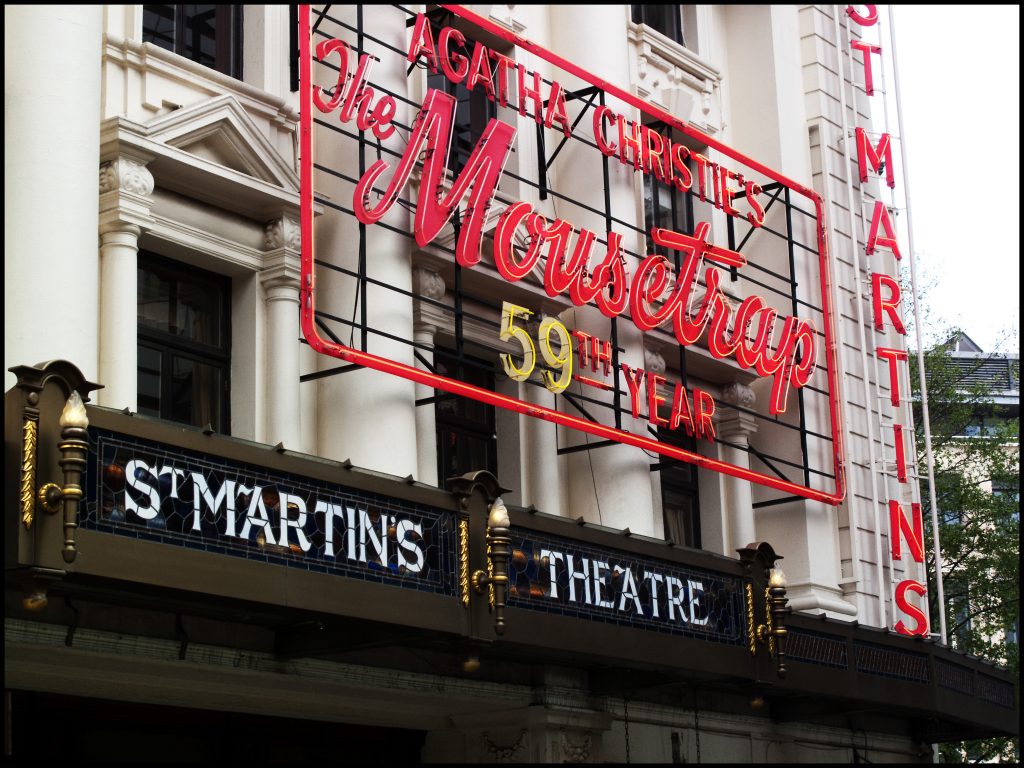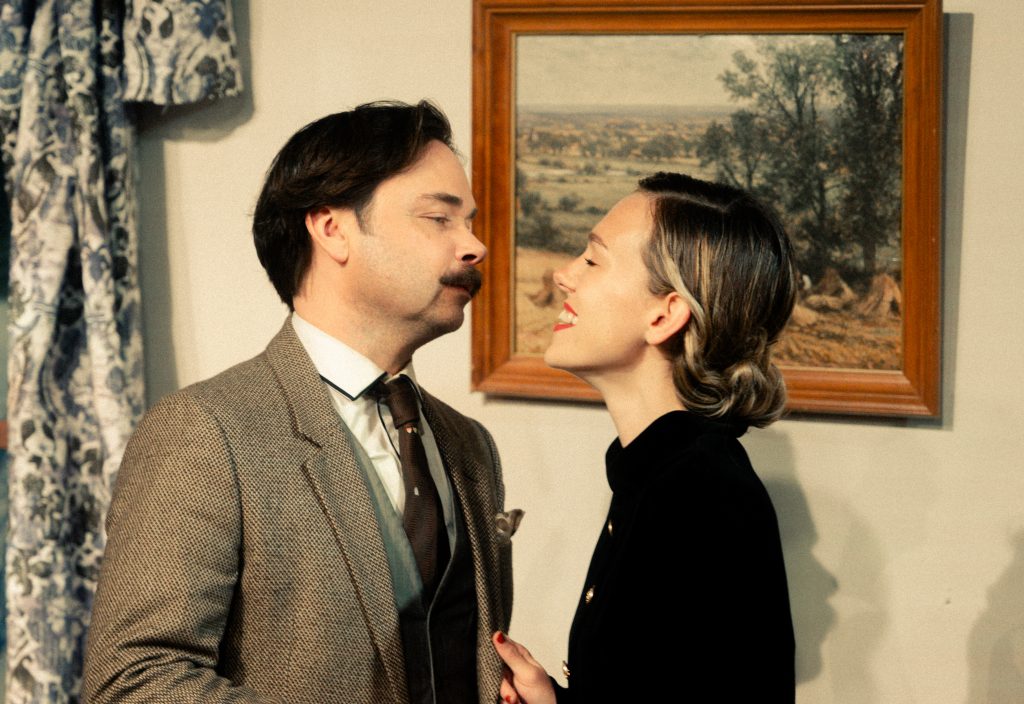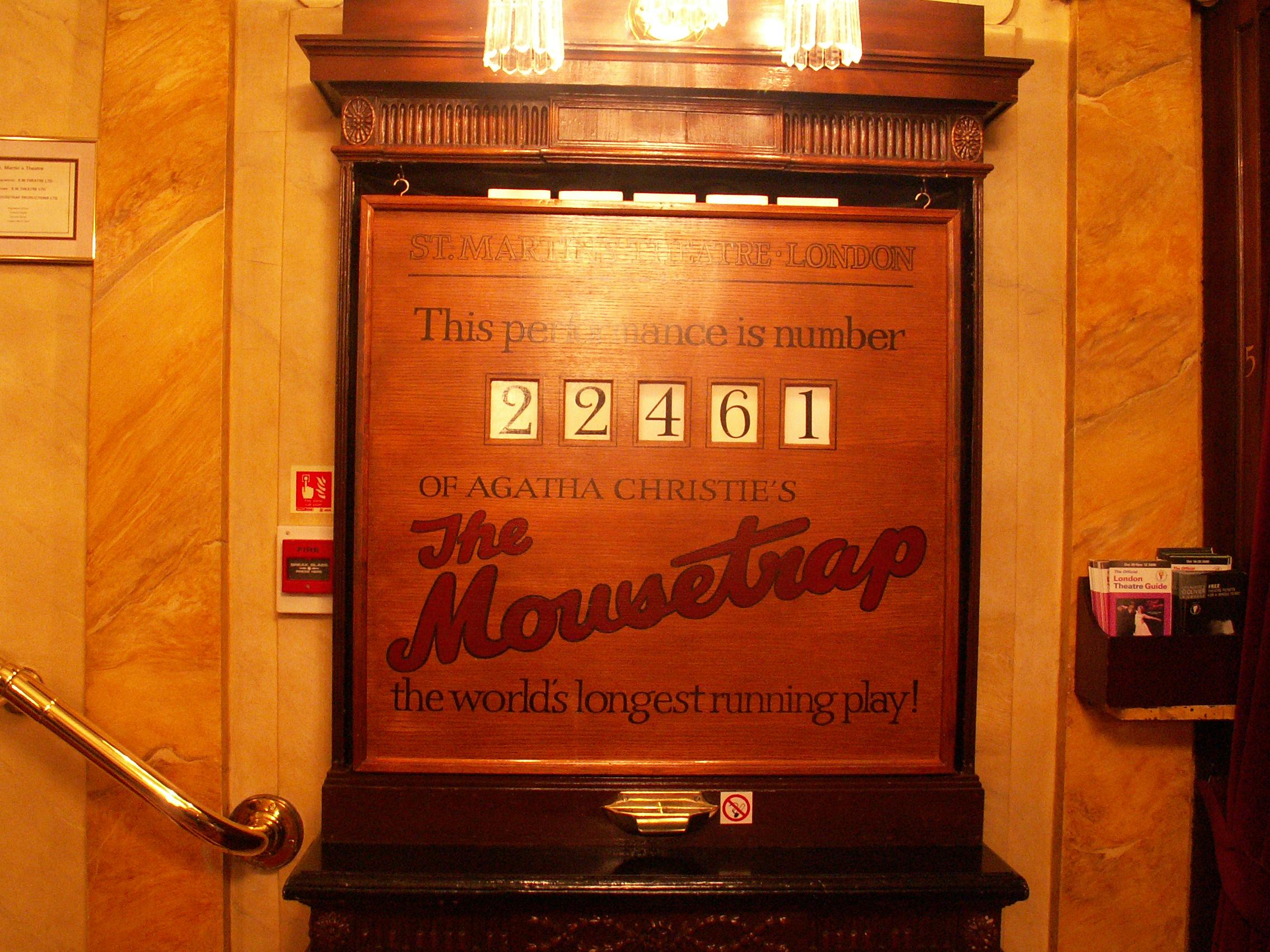The Mousetrap by Agatha Christie: The Play That Outsmarted Time
I’ve adored Agatha Christie for as long as I can remember. My shelves are packed with her books in both Kindle and paperback form. There’s something comforting about having her stories close at hand, ready to revisit whenever I need a dose of sharp wit and clever plotting. Hercule Poirot is my favourite detective, but my heart will always belong to And Then There Were None. That story was the first time I truly realised how brilliant Christie was at combining psychology, tension, and moral consequence. I recall first reading it on a plane to Ibiza, and I’ve revisited the book many, many times since.
So when my mum surprised me with tickets to see The Mousetrap for my fortieth birthday, it felt like a bucket list moment. Sitting in the theatre that night, surrounded by whispers of “who do you think did it?”, I was in heaven. And yes, I did manage to solve it before the reveal, but like any true Christie fan, I have kept the secret ever since.

This play is a legend, both in theatre and crime fiction. It is clever, atmospheric, and endlessly fascinating. But The Mousetrap is more than just a mystery play. It is a piece of living history.
What Is the Story of The Mousetrap?
The play begins on a snowy evening in post-war England. A young couple, Mollie and Giles Ralston, have just opened a country guesthouse called Monkswell Manor. Their first guests arrive as a blizzard closes in, cutting the house off from the outside world.
Each guest has their own quirks and secrets. There is the excitable architect Christopher Wren, the stern spinster Mrs Boyle, the dignified Major Metcalf, the aloof Miss Casewell, the mysterious foreigner Mr Paravicini, and the confident young man who suddenly appears unannounced.
When a police detective, Sergeant Trotter, arrives on skis to warn them of a murderer on the loose, tensions rise. He believes the killer is among them. And as the storm rages outside, suspicion turns inward.
What follows is classic Christie. Lies unravel. Characters reveal their pasts. And when the murderer finally strikes again, the truth is far more shocking than anyone could imagine.
At its core, The Mousetrap is about guilt, justice, and the lingering effects of childhood. It takes the familiar “country house mystery” and turns it into something deeply human and quietly tragic.
Why Is It Called The Mousetrap?
The title comes from Shakespeare’s Hamlet. In the play, Hamlet stages a murder mystery to expose his uncle’s guilt. When asked what the play is called, Hamlet replies, “The Mousetrap.” Christie loved literary references, and she used this one perfectly. Her play is also a trap, set to catch the guilty party.
It’s a fitting metaphor, both for the story itself and for the audience experience. As we watch, we too are caught in the trap, trying to piece together the puzzle before the final reveal.
A Short History of a Theatrical Phenomenon
The Mousetrap first opened on 6 October 1952 at the Ambassadors Theatre in London. It moved next door to St. Martin’s Theatre in 1974, where it still runs today. This makes it the longest-running play in the world, with over 29,000 performances to date.
Agatha Christie originally wrote it as a short radio play called Three Blind Mice, which was broadcast in 1947 as a birthday gift for Queen Mary. The stage version was later commissioned by theatre producer Peter Saunders, who convinced Christie to adapt the story.
Christie herself never expected the play to run so long. In her autobiography, she wrote, “It’s the sort of play you can take on tour for eight months and then forget.” She thought it might last a year or two at best. Over seven decades later, it shows no sign of slowing down.
The Original Cast of The Mousetrap
When the play premiered in 1952, the original cast included:
- Sheila Sim as Mollie Ralston
- Richard Attenborough as Detective Sergeant Trotter
- Martin Miller as Mr Paravicini
- Allan McClelland as Christopher Wren
- Agneta Eckemyr as Miss Casewell
- Aubrey Dexter as Major Metcalf
- Margo Johns as Mrs Boyle
- David Raven as Giles Ralston
Richard Attenborough and Sheila Sim were not only the stars of the first production, they were also married in real life, which added an extra touch of authenticity to the Ralstons’ relationship.
The show famously kept one cast member on stage longer than any other actor in theatre history. David Raven, who played Major Metcalf in later years, performed the role 4,575 times, earning a place in the Guinness World Records.
How Does The Mousetrap Keep Its Ending a Secret?
At the end of every performance, the cast turns to the audience and asks them not to reveal the ending to anyone else. It’s a simple but incredibly effective ritual. And audiences have respected it for over seventy years.
In a time before the internet, this secrecy was protected by tradition. Today, even in the age of social media, most people still honour Christie’s wish. The mystery remains unspoiled because theatre-goers recognise that keeping the secret is part of the fun.
There is also a certain camaraderie among those who have seen it. Once you know the twist, you become part of an unspoken club, one that values the surprise too much to ruin it for others. And those who do spoil the surprise lose their membership!
Why Is There No Film of The Mousetrap?
Agatha Christie was a shrewd businesswoman as well as a gifted writer. She sold the film rights to The Mousetrap decades ago, but with one brilliant condition: no film adaptation could be made until six months after the London stage production closed.
Since the show has never closed, the film has never been made. I’m glad this is the case. If a film were to be made, the secret of whodunnit would be unlikely to remain the secret it currently is. The Mousetrap feels like the “listed building” of plays. It can’t be touched (and possibly butchered) by Hollywood.
There was, however, a clever tribute to it in 2022’s See How They Run, a comedy whodunnit starring Saoirse Ronan and Sam Rockwell. The film is set around a fictional murder that takes place backstage during The Mousetrap’s original run. It captures the spirit of Christie’s world perfectly, without breaking her famous rule.
How Long Is The Mousetrap?
The play runs for approximately two hours and fifteen minutes, including a short interval. That timing has remained consistent for decades. It’s long enough to build suspense and character depth, but never drags.
Christie’s dialogue is crisp and full of clues. Every line matters. Even the smallest aside can point toward the truth if you’re paying attention.

Interesting Facts About The Mousetrap
- The play has been translated into more than 25 languages and performed in over 50 countries.
- A new cast takes over every year, with rehearsals still held in London’s West End.
- During its 70th anniversary in 2022, The Mousetrap had special performances featuring members of past casts, including the late Richard Attenborough’s grandson.
- The theatre has seen its fair share of celebrity guests. The Queen, Prince Charles, and countless stars have attended over the decades.
- It’s estimated that more than 10 million people have seen the show in London alone.
- The original set design, by Roger Furse, has been faithfully maintained with only subtle updates.
- When The Mousetrap reached its 25th anniversary in 1977, Agatha Christie herself sent a letter saying she hoped it would “run forever.” So far, it has.
Why The Mousetrap Endures
The success of The Mousetrap is more than a curiosity. It’s a testament to Christie’s deep understanding of human nature. Her mysteries aren’t just puzzles; they’re studies in motive, emotion, and moral choice.
The play doesn’t rely on special effects or gimmicks. It survives because it delivers what audiences love most: suspense, laughter, and a satisfying conclusion. Every night, new audiences sit in the same theatre, experience the same shocks, and leave with the same vow of silence.
For many, it’s their first experience of live theatre. For others, it’s a nostalgic trip back to the golden age of British storytelling. But for all, it is something special, a moment frozen in time and tradition.
Behind the Curtain: The Making of a Classic
Agatha Christie wrote The Mousetrap in her early sixties, at a point when she had already achieved global fame. By then, she was the most published novelist in history, second only to Shakespeare and the Bible in total sales.
She often said she preferred playwriting to novel writing because she loved the immediacy of seeing her work come alive on stage. Unlike her books, which could take months to reach readers, a play gave her instant feedback through the audience’s reactions.
Christie based the story loosely on a real-life case, the death of a boy named Dennis O’Neill in 1945, who had been abused by his foster parents. She was horrified by the case and used it as inspiration for the tragic backstory that lies beneath the play’s plot.
It is this human element that gives The Mousetrap its power. Beneath the clues and red herrings lies a story about pain, revenge, and compassion. It’s a crime story with a heart, which is what Christie always did best.
Is The Mousetrap a Good Play?
Oh, of course it’s good!!! It’s a piece of theatre history. The joy of The Mousetrap isn’t just in the mystery, but in its enduring charm. It’s the kind of story that feels perfectly at home on a rainy evening, with a cup of tea and the sound of thunder rolling outside. Except instead of being at home, you’re at the theatre!
When I saw it, I was completely drawn in. The set was warm and old-fashioned, with flickering lamps and thick curtains, exactly how I’d imagined it. The cast captured that classic British blend of politeness and paranoia.
FAQ: Everything You Want to Know About The Mousetrap
When did The Mousetrap premiere?
6 October 1952, at the Ambassadors Theatre in London.
How long has it been running?
Over 70 years and counting, making it the longest-running play in history.
Who wrote it?
The great Agatha Christie.
Where can you see it?
It’s currently playing at St. Martin’s Theatre, London, and regularly tours the UK.
Why has it lasted so long?
Because it delivers timeless entertainment, blending suspense, humour, and humanity.
Can I find it online or on film?
No, and that’s part of its charm. Christie’s legal agreement prevents any film adaptation until the play closes.
How long is the performance?
About two hours and fifteen minutes, including an interval.
Final Thoughts
The Mousetrap is more than a play. It’s a ritual for mystery lovers, a celebration of storytelling, and a love letter to the art of theatre itself.
Seeing it reminded me of why Agatha Christie continues to inspire me. Her stories are clever, compassionate, and utterly timeless. She understood people, their fears and desires, and she knew how to turn that understanding into the perfect mystery.
As for the ending? Not a chance you’ll find that here!
Agatha Christie is coming to Long Eaton next year! Arcade Players will present And Then There Were None at The Duchess Theatre in Long Eaton. Tickets will be available soon, so keep an eye on their website for updates.







